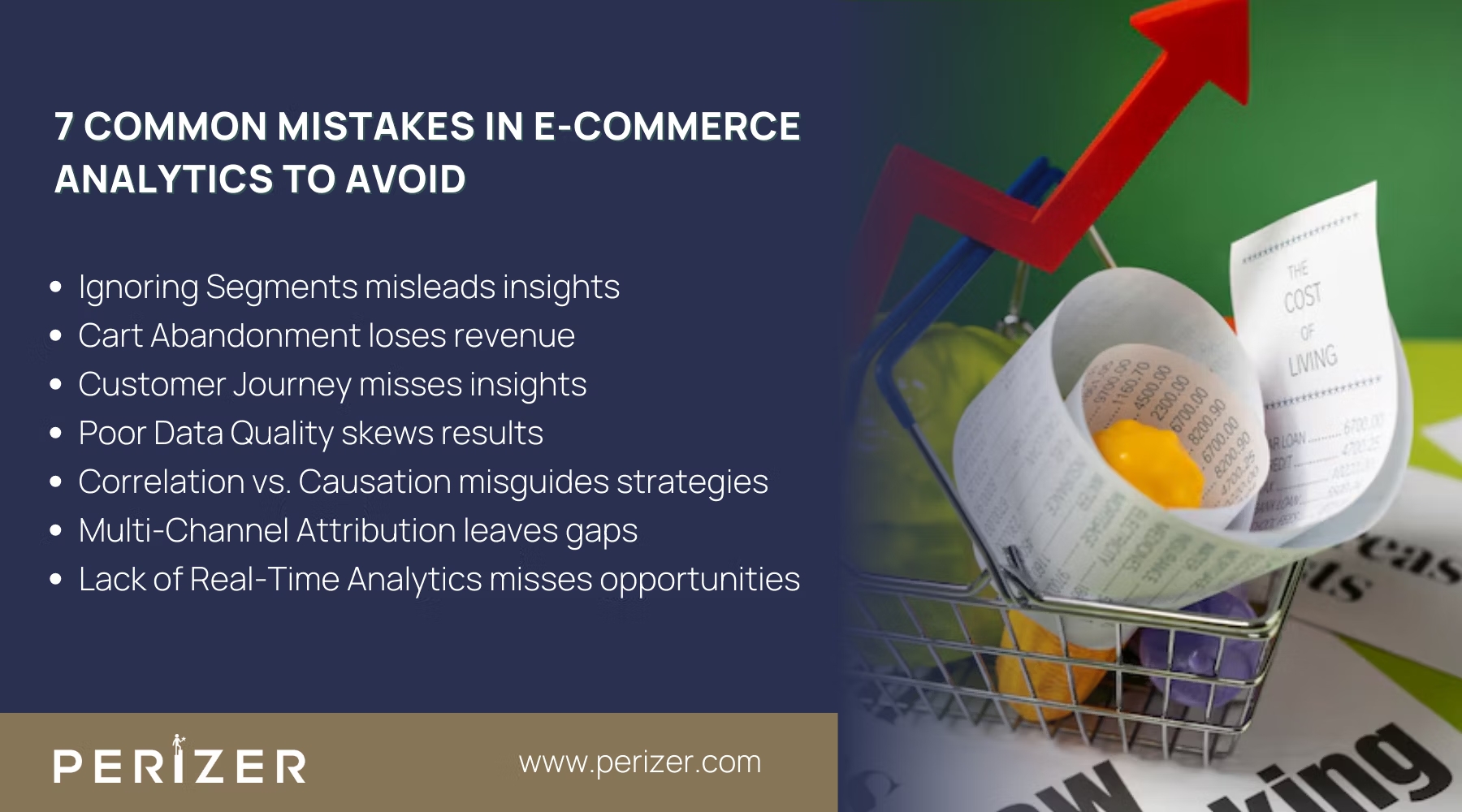7 Common Mistakes in E-commerce Analytics to Avoid
Discover 8 costly e-commerce analytics mistakes and learn how to use advanced techniques to make your data a real driver of business growth.

Many e-commerce businesses unknowingly make serious mistakes in their analytics, causing them to miss opportunities and lose revenue. These errors often come from a lack of deep understanding, resulting in skewed data and misguided strategies. Even experienced professionals fall into costly traps like ignoring segmented sales analysis or misinterpreting customer journey data.
These mistakes not only hinder growth but also waste valuable resources and time. By spotting and fixing these issues, you can greatly improve your analytics and see much better results, growing your e-commerce success.
In this guide, we explore eight common e-commerce analytics mistakes and how to avoid them to sharpen your approach, gain an edge, and find new opportunities.
7 Common Mistakes in E-commerce Analytics to Avoid

1. Ignoring Segmented Sales Performance Analysis
Ignoring segmented sales performance analysis can lead to a skewed understanding of your e-commerce business. To avoid this, focus on breaking down sales data into specific segments such as product categories, customer demographics, and purchase channels.
How Does It Work?
Segmentation involves categorizing your sales data to see trends and patterns that are not apparent in aggregate data. This helps you understand which products are performing well among specific customer groups and through which channels.
How to Do It?
Use advanced analytics tools like Google Analytics, Adobe Analytics, or custom BI solutions to set up segmentation. Create segments based on relevant criteria such as age, location, purchase history, and product type. Analyze each segment separately to identify unique trends and insights.
For instance, you might find that certain products perform better with a younger demographic on social media channels. This information can guide targeted marketing campaigns and product development strategies. Regularly updating and reviewing your segments ensures you stay ahead of market shifts and customer preferences.
2. Overlooking Cart Abandonment Rate Optimization
Cart abandonment significantly impacts revenue. Many businesses overlook optimizing their cart abandonment rates, resulting in missed sales opportunities.
How Does It Work?
Tracking and analyzing cart abandonment rates involves monitoring how often customers add items to their cart but do not complete the purchase. This metric provides insights into potential barriers in your checkout process.
How to Do It?
Set up cart abandonment tracking using tools like Google Analytics or customized e-commerce platforms such as Shopify and Magento. Implement scripts to capture cart data and abandonment events. Analyze this data to identify common drop-off points and reasons for abandonment.
To reduce abandonment rates, consider strategies like personalized follow-ups through email or retargeting ads. Implement exit-intent pop-ups offering discounts or incentives to complete the purchase. Regularly test and optimize your checkout process for a seamless customer experience.
3. Failing to Analyze the Complete Customer Journey
The customer journey is more than just a series of transactions. Failing to analyze the complete journey means missing out on valuable insights into customer behavior and preferences.
How Does It Work?
Mapping the customer journey involves tracking every touchpoint a customer interacts with, from initial awareness to post-purchase engagement. This holistic view helps identify opportunities to improve the customer experience.
How to Do It?
Use tools like Adobe Customer Journey Analytics, Hotjar, or Segment to capture and analyze customer interactions. Map out the journey stages, including awareness, consideration, purchase, and post-purchase. Collect data on each interaction to understand customer motivations and pain points.
Analyzing the customer journey can show important insights, such as the most influential touchpoints that lead to conversions or stages where customers drop off. Use this information to optimize marketing strategies, personalize customer interactions, and improve overall satisfaction.
4. Neglecting Data Quality and Integrity
High-quality data is the foundation of accurate e-commerce analytics. Neglecting data quality and integrity leads to flawed insights and poor decision-making.
How Does It Work?
Data quality involves ensuring that your data is accurate, complete, and consistent. Integrity refers to maintaining data accuracy and consistency over its lifecycle.
How to Do It?
Implement data cleaning processes to remove duplicates, correct errors, and fill in missing values. Use validation rules and automated tools to maintain data quality. Regularly audit your data sources and systems to ensure ongoing integrity.
Invest in data governance frameworks to establish standards and procedures for data management. Use machine learning algorithms to detect anomalies and inconsistencies in real-time. High-quality data enables more accurate predictive analytics and better-informed business decisions.
5. Misinterpreting Correlation as Causation
A common mistake in data analysis is interpreting correlation as causation, leading to misguided strategies and actions. Correlation indicates a relationship between two variables, but it does not imply that one causes the other. Causation, on the other hand, establishes a cause-and-effect relationship.
How to Do It?
Use statistical methods like regression analysis, controlled experiments, and causal inference techniques to distinguish between correlation and causation. Validate your findings with real-world testing and experimentation.
Understanding causation allows you to make the best decisions. For example, identifying that a specific marketing campaign directly increases sales (causation) is more actionable than knowing they simply move together (correlation). This clarity leads to more effective strategies and resource allocation.
6. Ignoring Multi-Channel Attribution
In a multi-channel world, ignoring multi-channel attribution leads to an incomplete understanding of your marketing efforts' effectiveness. Multi-channel attribution assigns credit for conversions to various touchpoints across different channels, providing a holistic view of customer interactions.
How to Do It?
Implement multi-channel attribution models using tools like Google Attribution, Attribution by HubSpot, or advanced analytics platforms. Set up tracking across all marketing channels and touchpoints, and apply attribution models to distribute credit accurately.
Different attribution models (e.g., linear, time decay, position-based) offer unique perspectives. Analyzing these models helps you understand which channels and interactions contribute most to conversions. This insight guides more effective marketing spend and strategy optimization.
7. Underestimating the Power of Real-Time Analytics
Real-time analytics provide immediate insights, yet many businesses underestimate their value, missing out on timely decision-making opportunities. Real-time analytics involve processing and analyzing data as it is generated, offering instant insights and enabling quick responses to changing conditions.
How to Do It?
Deploy real-time analytics tools like Google Analytics Real-Time, Looker, or custom real-time dashboards. Integrate these tools with your existing data systems to capture and process data continuously.
Real-time analytics empower you to react swiftly to market trends, customer behavior changes, and operational issues. For instance, real-time monitoring of a marketing campaign can reveal underperforming ads, allowing you to adjust strategies on the fly. This agility can significantly enhance your competitive edge.
Conclusion
To succeed in e-commerce analytics, you need to move beyond the basics and dig into the details. Avoiding mistakes like misinterpreting customer data or missing out on segmented sales analysis is essential for gaining useful insights. Focus on improving cart abandonment rates and ensuring your data is accurate.
By fine-tuning your methods and staying flexible in the fast-moving e-commerce world, you’ll make your analytics a real asset. This approach will help your business expand and maintain its edge. Start using these advanced practices to make your analytics a central part of your success.
FOCUSED, FAST, GOVERNMENT READY
Stay Tuned With Our Latest Insights

Staff Augmentation
Learn how to select the perfect IT outsourcing partner to promote your team’s capabilities, improve productivity, and drRead more...

Staff Augmentation
Find the perfect staff augmentation partner by aligning your goals, evaluating expertise, managing costs, and ensuring aRead more...

Cyber Security
We focus on understanding the needs, behaviors, and expectations of your users through extensive user research. This infRead more...